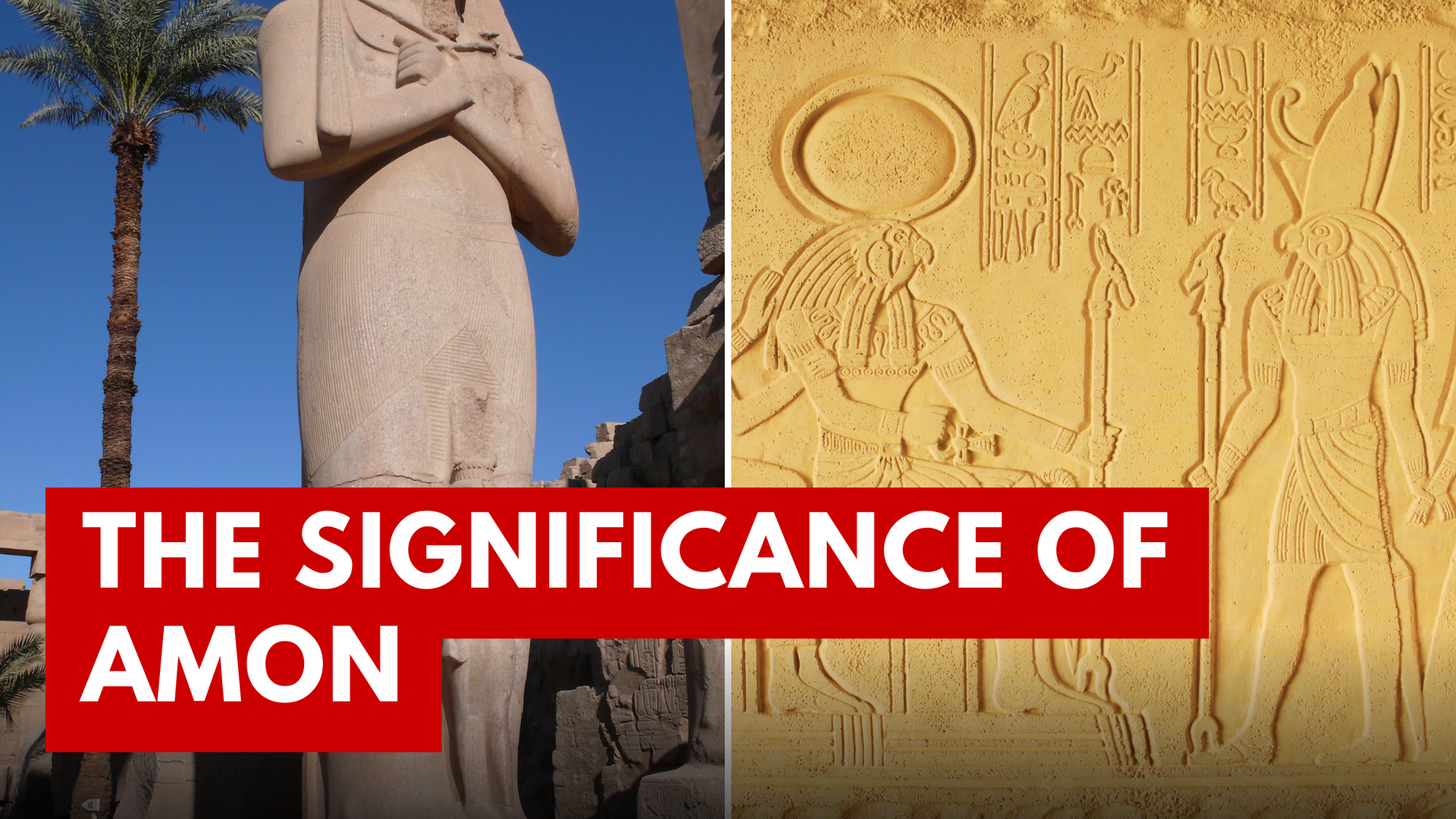The Significance of Amon: Exploring the King of the Gods in Ancient Egyptian Mythology

Introduction to Amon
In the vast tapestry of ancient Egyptian mythology, few deities stand as prominently as Amon. Known for his immense power and influence, Amon was revered as the king of the gods, holding a pivotal role in shaping the spiritual beliefs of ancient Egypt. His significance extends beyond mere mythology, as he was a central figure in the religious practices and daily lives of the Egyptians.
During the New Kingdom, a period marked by prosperity and cultural flourishing, Amon's worship reached its zenith. His cult became widely popular, with grand temples and monuments erected in his honor. This era solidified his status, embedding him deeply into the fabric of Egyptian society and culture.
Amon's identity is as fascinating as it is multifaceted. Often referred to as both Amon and Amun, this dual identity reflects his diverse roles and attributes. As Amun, he was associated with hiddenness and mystery, emphasizing his unseen power and the intricate nature of his divinity. His dual nature captures the complexity and depth of ancient Egyptian beliefs, offering a glimpse into the reverence and awe he inspired.
Through this exploration of Amon's origins and significance, we begin to unravel the rich mythology that continues to captivate and educate us about the ancient world.
Origins of Amon
In the mystical origins of ancient Egyptian mythology , Amon began as a lesser-known deity among the eight gods of the Hermopolite creation myth. With time, his influence expanded dramatically, reaching the grand city of Thebes. Here, Amon's presence flourished, intertwining with the political rise of Thebes itself. By the reign of Mentuhotep I, he had already become the patron of pharaohs, marking the start of a new era.
Originally a local fertility god, Amon's transformation into the king of the gods is a tale of divine evolution. His elevation was marked by a key fusion with the sun god Re, becoming Amon-Re, a composite deity embodying both creative and life-giving powers. This syncretism solidified his status as a national god, revered by all.
Thebes, known as P-Amen or "the abode of Amon," became the heart of his worship. The city's rulers, especially during the Middle and New Kingdoms, harnessed Amon's growing power to legitimize their authority. This divine connection not only elevated Amon but also established Thebes as a religious and political powerhouse. Thus, the story of Amon is not just one of divine ascent but also of the enduring legacy of Thebes in the annals of Egyptian history.
Amon's Role in Creation
Among the pantheon of ancient Egyptian deities , Amon emerged as a mighty creator god. Known as 'the Hidden One,' he encapsulated the mysteries of creation and the universe. Amon's rise to prominence is intertwined with his union with the sun god Re, forming the composite deity Amon-Re. This association not only underscored his role as a life-giver but also highlighted his connection to the sun, a vital source of life and energy.
Amon was depicted as a bearded man or as a ram, symbolizing his association with fertility and power. His influence extended beyond creation myths, as he was revered as a universal god capable of embodying all aspects of existence, including the nurturing elements of fertility and the illuminating potency of the sun.
In the broader context of creation myths, Amon's narrative shares common threads with stories from other cultures. Like the Genesis account, which speaks of order emerging from chaos, Amon's myth emphasizes the imposition of cosmic order. This reflects universal themes echoed in various traditions , where the divine often orchestrates harmony in an initially chaotic world.
Symbolism of Amon
The representation of Amon with a ram's head and solar disc is steeped in profound symbolism. The ram's head, adorned with majestic curved horns, embodies Amon's attributes of power and fertility. This imagery is not merely decorative; it signifies his vital role as a life-giver and protector in ancient Egyptian mythology.
"The ram symbolizes power, fertility, and the solar aspect of Amun Ra," notes scholars, highlighting the deity's overarching influence. The ram's connection to fertility aligns with the life-giving forces of the Nile, whose annual floods were crucial for Egypt's agricultural prosperity.
Complementing this is the solar disc, an emblem of the sun's sustaining force. Like the Aton Hymn describes, the solar disc represents the sun’s daily cycle, embodying creation and the continuous renewal of life. This imagery not only underscores Amon's divine nature but also his integral role in the cosmic order.
Together, these symbols encapsulate a deity who is both a potent force and a nurturing creator, whose influence extends from the heavens to the fertile banks of the Nile.
Amon and Other Deities
Amon's role in Egyptian mythology is intricately linked with other major deities, most notably Ra and Osiris. Together, these connections shaped the spiritual and cultural practices of ancient Egypt. In his combined form as Amon-Ra, Amon merged with the sun god Ra, elevating him to the status of the supreme national god. This fusion embodied the power of the sun and creation, reinforcing Amon's role as a life-giver and ruler.
Similarly, Amon's association with Osiris, the god of the afterlife, intertwined themes of resurrection and the cycles of nature. Both deities shared connections to the mysteries of creation, highlighting the syncretic nature of Egyptian religion. Amon's temporary role as the judge of the dead further connects him to Osiris, emphasizing their shared influence over the afterlife.
The impact of these associations extended to rituals and worship practices. Temples dedicated to Amon, such as those in Nubia, became centers of religious and community life, where large festivals celebrated Amon's significance. These practices helped consolidate religious power and reinforced the pharaoh's divine right to rule.
| Deity |
Association |
|---|---|
| Amon-Ra |
Sun, Creation |
| Osiris |
Afterlife, Resurrection |
Together, these relationships illustrate a complex tapestry of beliefs that underscored the moral and ethical frameworks of Egyptian society.
Temples and Monuments
The Karnak Temple , dedicated to Amon, stands as one of the most majestic religious sites in ancient Egypt. Spanning over 200 acres, its colossal columns and towering obelisks draw millions of visitors each year. This temple complex not only showcases architectural brilliance but also serves as a testament to Amon's widespread worship. It was a pivotal spiritual hub where pharaohs sought the divine favor of Amon, ensuring prosperity and stability.
Pharaohs played an essential role in the construction of Amon's monuments, using these grand structures as symbols of their divine right to rule. During the New Kingdom, rulers like Hatshepsut, Ramses II, and Seti I significantly expanded the Karnak Temple Complex. Their inscriptions and reliefs often depicted pharaohs in the presence of Amon, reinforcing their divine connection.
Beyond their religious significance, these temples were cultural landmarks. The Temple of Amun at Jebel Barkal illustrates this beautifully, integrating religious, social, and economic aspects of ancient life. These monuments, with their intricate carvings and vast courtyards, emphasize the rich cultural heritage of ancient Egypt, highlighting the enduring legacy of Amon's worship.
Amon's Influence Beyond Egypt
The worship of Amon extended far beyond Egypt's borders, profoundly impacting neighboring regions like Nubia and Libya. Historically, the Nile River served as a vital conduit for cultural exchange, facilitating the spread of Amon's worship into Nubia. During Egypt's Middle and New Kingdoms, Egypt expanded into Nubia, establishing it as a colonial province and building temples dedicated to Amon, such as the prominent one at Jebel Barkal. This temple became a key spiritual center, symbolizing the unification under Amon's worship.
As the Kingdom of Kush rose, the Kushite rulers adopted Amon to legitimize their rule, blending Egyptian and local beliefs. This religious syncretism not only reinforced political authority but also fostered a shared cultural identity. In Libya, though less documented, trade and military interactions likely facilitated similar cultural exchanges.
Overall, Amon's influence reshaped local religious landscapes, integrating Egyptian practices into indigenous cultures and resulting in a rich tapestry of beliefs that endured for centuries. This spread of worship highlights the dynamic interplay between cultures, showcasing the enduring legacy of Amon's significance beyond Egypt.
Conclusion: Legacy of Amon
Amon's profound influence on ancient Egyptian culture cannot be overstated. As the king of the gods, he played a pivotal role in shaping religious practices and societal structures. His worship not only unified Egypt but also extended to neighboring regions like Nubia and Libya, illustrating the strength of cultural exchange and religious syncretism. The establishment of expansive temple complexes, such as the Temple of Amun at Jebel Barkal , stands as a testament to his enduring significance.
The lessons from Amon's worship offer insights into the dynamics of power, religion, and cultural integration. His legacy highlights the importance of understanding and preserving ancient history, as it provides a window into the past that informs our present and future. The surviving temples, artifacts, and art continue to captivate and educate, reminding us of the rich tapestry of beliefs that once flourished. In preserving these relics, we honor the complex heritage of ancient civilizations and ensure that the stories of Amon and his followers remain alive for generations to come.
Limited Time Offer
Become a Successful NDIS Provider
$689 $349
Use code EARLY349 at checkout
News Feed







